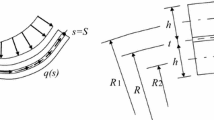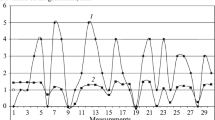Selective quality control of manufactured multilayer windshields was conducted. Deviations of curved products from a specified shape were brought to light. Linear regression models describing the dependence of sagging of the glass on the curving temperature were devised. Simulation modeling of the algorithm controlling the curving process shows that the quality of the manufactured laminated glass can be improved.

Similar content being viewed by others
References
R. I. Makarov and E. R. Khorosheva, “Salient aspects of the implementation of digital economics in glass plants in Russia,” Glass Ceram., 75(11 – 12), 438 – 440 (2019) [Steklo Keram., No. 11, 26 – 28 (2018)].
GOST 5727–88. Safety Glass for Ground Transport. General Technical Conditions [in Russian], Standartinform, Moscow (2006).
R. I. Makarov, “Morphological approach to taking corrective actions in quality control systems for laminated glass production,” Glass Ceram., 65(7 – 8), 227 – 230 (2008) [Steklo Keram., No. 7, 13 – 16 (2008)].
R. I. Makarov, “Curving control in the production of laminated automotive glass,” Algorithmy, Metody Sist. Obrab. Dannykh, Electronn. Zh., No. 3(32), 57 – 61 (2015).
Author information
Authors and Affiliations
Corresponding authors
Additional information
Translated from Steklo i Keramika, No. 9, pp. 9 – 11, September, 2021.
Rights and permissions
About this article
Cite this article
Makarov, R.I., Khorosheva, E.R. Multilayer Glass Quality Improvement during Production. Glass Ceram 78, 350–352 (2022). https://doi.org/10.1007/s10717-022-00409-0
Published:
Issue Date:
DOI: https://doi.org/10.1007/s10717-022-00409-0




